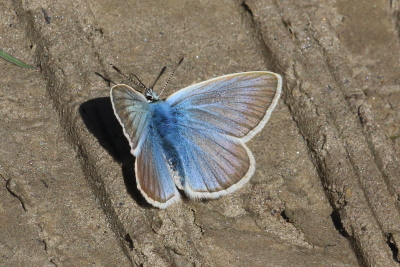











Damon
Blue (Polyommatus damon)
2024 photographs highlighted in yellow. Click on any photograph to go to an enlarged picture, or simply scroll down the page.
|
I
first saw a single male in the Queyras National Park in 2000, and then another at Isola in
2002. However, in 2003 at the Col de Lauteret near Briançon I saw another, then another and then realised
that they could be counted in hundreds if not thousands.
|
Damon is slightly unusual in that the underside ground colour is often brown in the male as well as the female, whereas for most blues the male is grey (or greyer) than the usually-brown female. However, as shown above, the male upperside is strongly blue and the female brown. The male upperside could possibly be confused with the Amanda's Blue (P. amandus) in terms of the dark borders, although damon is rather darker and smaller than amandus and the undersides are completely different.
This species was previously known as Agrodiaetus damon.
|
| ref | sex |
observations |
alt. m |
| 17648 | M |
showing the characteristic dark borders which extend along the uph veins. |
2100 |
| 22199 | M |
a typical male. |
2020 |
| 41554 | M | a male, taking salts. A slightly paler blue than the norm. | 2020 |
| 53095 | M | a male, rather a pale blue but fresh as indicated by the perfect fringes. | 2020 |
| 3668 | F |
a typical female, plain brown and unmarked, with bluish suffusion on the thorax hairs and in the basal region. |
1800 |
| 22876 | F |
a rather worn female, showing a smattering of basal blue scales. It is on the larval hostplant Sainfoin (Onobrychis viciifolia). |
2150 |
| 41869 | M | a male underside, rather greyer and a less warm brown than the norm. | 2070 |
| 21970 | M |
a male, a fairly normal colouring in that the unf ground colour is rather greyish compared to the unh. |
2050 |
| 17862 | M |
a male, quite deep rich chestnut brown. Whether this is a geographical or an altitude effect of both 17862 and 22584, given that they were both seen in Isère and at very low altitudes for this species, is unclear. The colouring is certainly unusual. I am assuming that the fact that they are (or appear to be) taking salts indicates that both are males, but it is possible that they are females just taking moisture. |
1120 |
| 22584 | M |
a male, a lighter brown than 17862. |
1120 |
| 44866 | M | a male, roosting on Sainfoin in typical upside-down pose in inclement weather. | 2020 |
| 3707 | F |
a typical female underside, quite a strong clean brown on both wings. |
2000 |
17648_male_Hautes-Alpes_09Jul09
22199_male_Hautes-Alpes_14Jul10
41554_male_Hautes-Alpes_15Jul16
53095_male_Hautes-Alpes_14Jul24
3668_female_Alpes-de-Haute-Provence_13Aug06
22876_female_Valais, Switzerland_22Jul10
21970_male_Hautes-Alpes_11Jul10
44866_male_Hautes-Alpes_23Jul17
3707_female_Alpes-de-Haute-Provence_13Aug06